As the crisis in Syria continues to escalate, refugees are fleeing to the surrounding countries in huge numbers. According to the UNHCR, as of August 8 there are over one hundred thirty-eight thousand refugees registered for assistance – roughly fifty thousand in Turkey, thirty-nine thousand in Jordan, thirty-five thousand in Lebanon and twelve thousand in Iraq. Many other displaced Syrian civilians are not registered, and perhaps over one million are displaced within Syria. Neighboring countries, local organizations, and the international community are providing assistance to those fleeing the violence.
In March the UNHCR planned for one hundred forty thousand refugees as of December 2012 and appealed for eighty-four million dollars. Given the increasing number of refugees, the appeal was raised in June to one hundred ninety-three million dollars. Less than half has been funded. The unified appeal is coordinated among seven UN agencies and thirty-six NGO partners to respond to the needs of Syrian refugees in Jordan, Lebanon, Turkey, and Iraq. In addition to funding from governments (the United States is the largest donor by far), many national and religious charities from all over the world have contributed food aid, medical supplies, and services, as well as direct financial assistance to those providing aid and shelter to the refugees.
The photos below portray some of the experiences and conditions of the refugees in Jordan, Turkey, Iraq and Lebanon since March 2012.
JORDAN
Jordan opened its borders to Syrians when the conflict began more than eighteen months ago, as it did with Iraqi refugees following the 2003 US-UK invasion of Iraq. The Jordanian government estimates that some one hundred fifty thousand Syrians have crossed its border; nearly forty thousand have registered with UNHCR. Refugees were recently relocated from four overcrowded transit centers to the newly established Za`tari camp near Mafraq, seven miles from the Jordanian-Syrian border. Jordan has now closed the Bashabsheh camp and King Abdullah Park.
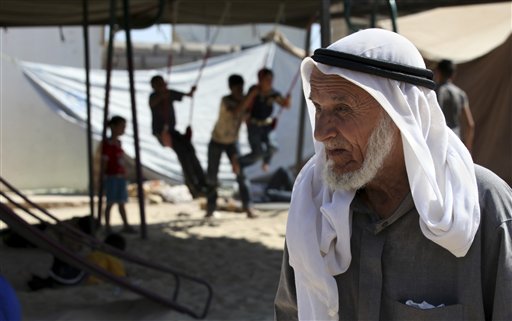
[A Syrian refugee passes by the playground at the Al Bashabsheh refugee camp in Ramtha, Jordan, 17 July 2012. Image by Mohammad Hannon/AP Photo.]
Funding for aid comes from all over the world, and local campaigns are successfully collecting donations for the refugees. Morocco recently set up a field hospital in Za`tari camp with seventy-five doctors and nurses from the Royal Armed Forces Hospital and sent sixty tons of basic foodstuffs such as sugar, flour, pasta and oil, and fifty-five tons of rice and milk powder for babies. Saudi Arabia sent forty-three trucks of food and water.
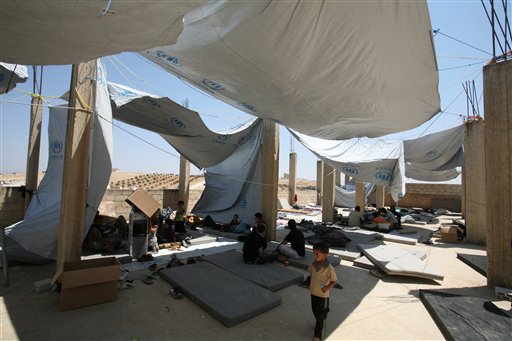
[Recently arrived Syrian refugees at Al-Bashabsheh refugee camp, in Ramtha, Jordan, 11 July 2012. Image by Mohammad Hannon/AP Photo.]
According to the UNHCR, when refugees arrive at the camps they are registered and given a tent assignment and ration card. They also receive household items, such as hygiene kits, blankets, and cooking supplies. Families of more than five persons are given a second tent.

[Jordanians and Syrian refugees attend Friday prayers in the Ramtha Grand Mosque, on the first day of the holy month of Ramadan, in Ramtha, near the Syrian border, 20 July 2012. Image by Mohammad Hannon/AP Photo.]
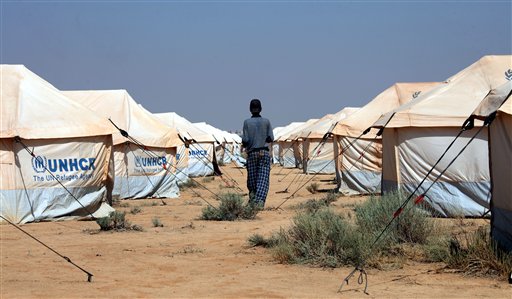
[A Jordanian works at setting up the first Jordanian tent camp for Syrian refugees in Zataari, Jordan, near the Syrian border, July 29, 2012. Image by Mohammad Hannon/AP Photo.]
The newly founded Za`tari camp can host ten thousand refugees, but may be expanded to serve one hundred thirteen thousand. Camp infrastructure requires piped water, electricity, and a level surface, as well as sanitation facilities and supplies. Providing these services is a logistical and costly challenge. In Za’tari camp, 168 tons of water are trucked in daily (roughly fifty liters per person, per day).
TURKEY
The Turkish government has taken responsibility for all Syrian refugees within its borders (50,227 as of August 8, 2012) and provided $15 million in aid. According to the UNHCR, “The Turkish Government has declared a temporary protection regime for Syrians, the core elements include: i) open border policy with admission to the territory for those seeking protection, ii) protection against forcible returns (non-refoulement) iii) access to basic registration arrangement, where immediate needs are addressed.”
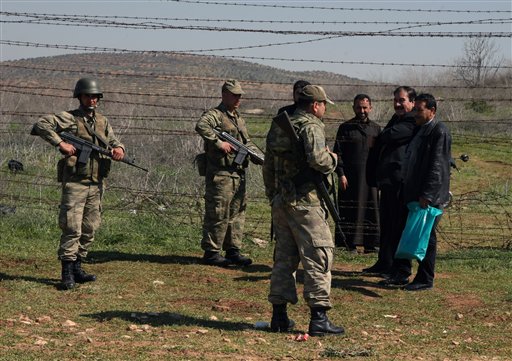
[Turkish soldiers speak with Syrian refugees entering at a border crossing near Reyhanli, Turkey, 20 March 2012. Image by Burhan Ozbilici/AP Photo.]

[A Syrian boy walks in between hundreds of tents at a refugee camp near the Turkish border town of Reyhanli, 21 March 2012. Image by Selcan Hacaoglu/AP Photo.]
Turkey’s role as host outside of established UN systems suggests that it sees itself playing a significant role in the region, one mirrored by its early efforts to intervene diplomatically when the regime crackdown began in 2011. Turkey has also been providing hot meals, medical care, and educational programing for children.
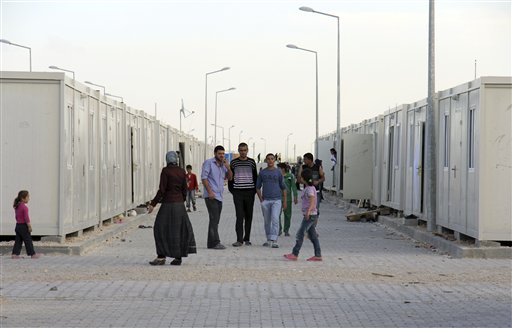
[Syrian refugee camp in Kilis, Turkey. 12 April 2012. Image by Germano Assad/AP Photo.]
As the Syrian and Jordanian governments did with Iraqi refugees, the Turkish government calls the Syrians “guests” rather than refugees. Turkey has provided nine tent camps and a container camp, while three new shelter camps are being set up in southern and southeastern Turkey. As of early August, those crossing into Turkey are sent to Ceylanpinar camp in Sanliurfa, which already hosts over 13,000 Syrian refugees. The vast majority of those crossing into Turkey in August are from Aleppo and surrounding villages.
IRAQ
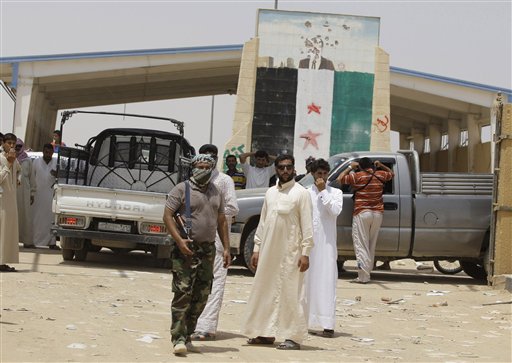
[Armed Syrian rebels stand guard as refugees flee Syria at the border crossing near the Iraqi town of Qaim, 25 July 2012. Image by Karim Kadim/AP Photo.]
Refugees are crossing into Iraqi Kurdistan and, more recently, via the al-Qaim border crossing into Anbar province, on the main Damascus-Baghdad highway. The majority of these refugees are from Deir al-Zor in eastern Syria, which has been a site of intense fighting. These borders are no longer under the control of the Syrian state. Two new camps have been established on the Iraqi side at al-Waleed and al-Qaim border crossings. In Iraqi Kurdistan (Duhuk, Erbil, and Sulaymania governorates), the Iraqi Department of Displacement and Migration (DDM), has allowed those living in the UNHCR’s Domiz Camp to apply for six-month temporary residency.
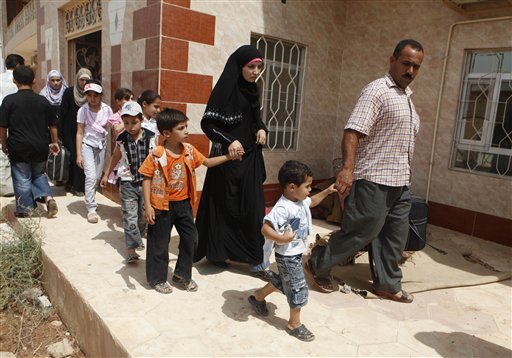
[Iraqi refugees from Syria arrive at the border crossing near the Iraqi town of Qaim, 25 July 2012. Over 15,000 Iraqis have fled the Syrian civil war over the last two weeks. Image by Karim Kadim/AP Photo.]
An estimated 750,000 Iraqis remain in Syria following the huge influx of Iraqis into the country after 2005, although as of 2012 only 100,000 were registered with UNHCR. Many had been awaiting resettlement to a third country. However, European countries stopped resettlement a number of years ago, and because of tense US-Syrian relations, US security personnel have not been allowed into Syria to interview the Iraqi refugees for two years. Despite this, many Iraqis stayed in Syria because of the relative security, low cost of living, and access to health care and education. Due to the fighting in Damascus and Aleppo, where almost all Iraqi refugees live, more than 21,000 Iraqis have returned to Iraq since July.
LEBANON
The Lebanese government maintains open borders for Syrian refugees, and currently over 35,000 are registered throughout Lebanon. At the same time, people are going back and forth across the border: in the last week of July, some 11,000 Syrians entered the country, and a similar number also returned to Syria. According to UNHCR, because of the ongoing fighting Syrians are now allowed to renew their residency permits in Lebanon without having to return to Syria to do so.
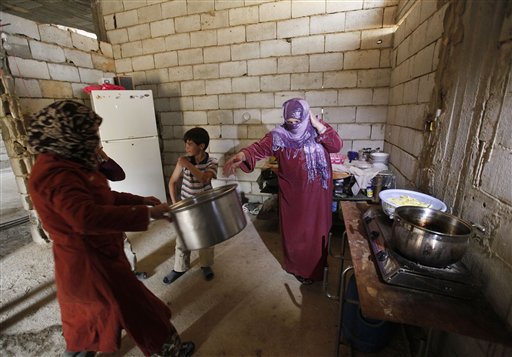
[Syrian refugees Lina al-Nahar, left, and Yussra Zardi cook at a house under construction, which they live in temporarily with their families, at the Lebanese-Syrian border town of Arssal, eastern Lebanon, 29 May 2012. Image by Hussein Malla/AP Photo.]
UNHCR interviews with refugees show that many of those who come to Lebanon plan to stay for a short time, until the fighting dies down. Most refugees to date are from the Homs and Idlib provinces. While many remain in the Bekaa Valley, many others have settled in and around Tripoli, staying in hotels or with family members or renting apartments. Fewer have ventured into the Beirut area, but with thousands now coming from Damascus and Aleppo, that may change.
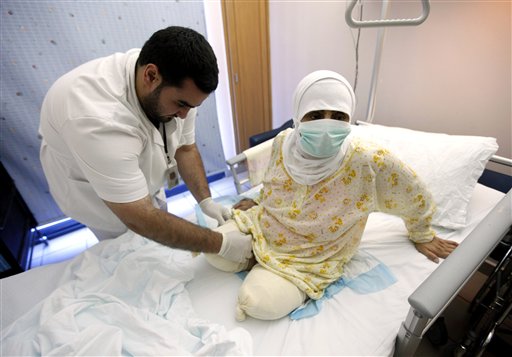
[A Syrian woman is treated by a Lebanese nurse at a hospital in Tripoli, Lebanon, 30 May 2012. Hassna, 37, lost both legs in a mortar shell attack, which also killed her two children and her husband when they were fleeing their house on a motorcycle. Image by Hussein Malla/AP Photo.]
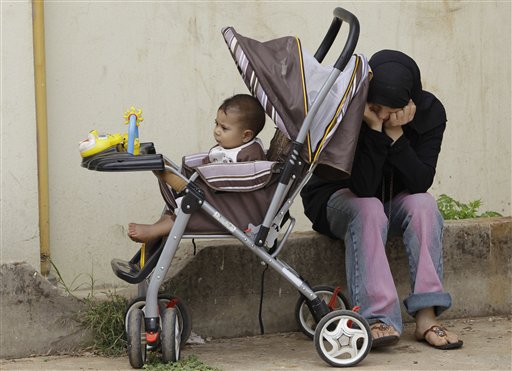
[A Syrian refugee woman, who fled her house in the town of Tal-Kalakh sits next to her baby at a school playground where she lives temporarily with her family and relatives, in Shadra village at the northern Lebanese-Syrian border town of Wadi Khaled, in Akkar, north Lebanon, 30 May 2012. Image by Hussein Malla/AP Photo.]
Both the Lebanese and Jordanian ministries of education make provisions for Syrian children to attend school. However, they must have Syrian school certifications, something that refugees rarely remember to bring with them. With the start of the school year less than a month away, UN officials are attempting to have this requirement waived. The Lebanese Ministry of Education is allowing children to attend school without the certifications, but in that case will not issue credit or reports of their attendance. The ministry has also provided a list of public schools no longer in use where refugees can take shelter.
[Text by Rochelle Davis, photos selected by Michelle Woodward.]